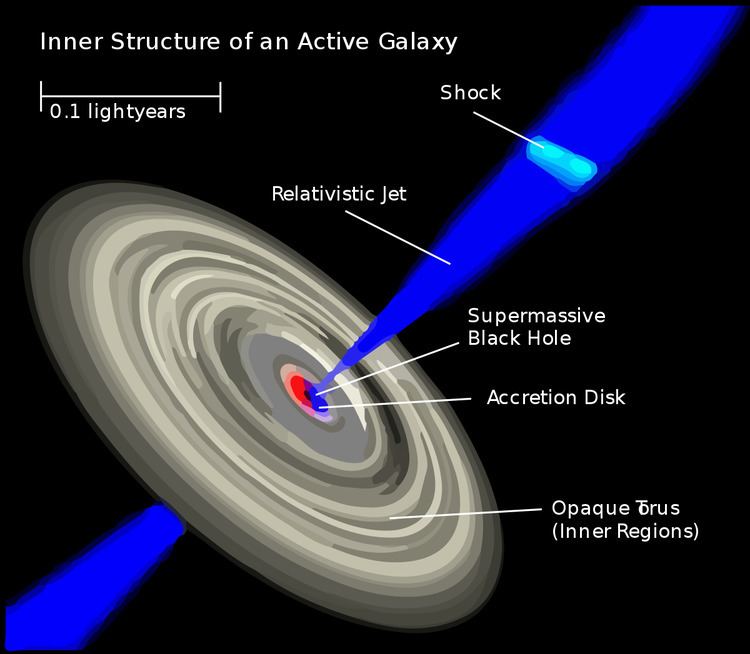 | ||
An astrophysical jet (hereafter 'jet') is an astronomical phenomenon where outflows of ionised matter are emitted as an extended beam along the axis of rotation. Formation and powering astrophysical jets is not fully understood, but it is likely that their origins are from dynamic interactions within accretion disks or from active processes associated with compact central objects: such as black holes, neutron stars or pulsars. When this greatly accelerated matter approaches the speed of light astrophysical jets become relativistic jets as they show effects under special relativity. It is not exactly known how jets are formed in accretion disks or how the matter is accelerated, but it is possibly due to generated tangled magnetic fields that aim two diametrically opposing beams away from the central source by angles only several degrees wide. (c.>1%.)
Contents
Many astronomical objects that contain jets include cataclysmic variable stars, X-ray binaries and Gamma ray bursters (GRB). Others are associated with star forming regions including T Tauri stars and Herbig–Haro objects, which are caused by the interaction of jets with the interstellar medium. Bipolar outflows or jets may also be associated with protostars, or with evolved post-AGB stars, planetary nebulae and bipolar nebulae.
Most of the largest and most active jets are created by super massive black holes (SMBH) black holes in the centre of active galaxies such as quasars and radio galaxies or within galaxy clusters. Such jets can exceed millions of parsecs in length.
Relativistic jets are beams of ionised matter accelerated close to the speed of light. Most have been observationally associated with central black holes of some active galaxies, radio galaxies or quasars, and also by galactic stellar black holes, neutron stars or pulsars. Beam lengths may extend between several thousand, hundreds of thousands or millions of parsecs. Jet velocities when approaching the speed of light show significant effects of the Special Theory of Relativity; for example, relativistic beaming that changes the apparent beam brightness (see the 'one-sided' jets below).
Massive central black holes in galaxies have the most powerful jets, but their structure and behaviours are similar to those of smaller galatic neutron stars and black holes. These SMBH systems are often called microquasars and show a large range of velocities. SS433 jet, for example, has a velocity of 0.23c. Relativistic jet formation may also explain observed gamma-ray bursts. Notably, even weaker and less relativistic jets may be associated with many binary systems.
Mechanisms behind the composition of jets remain uncertain, though some studies favour models where jets are composed of an electrically neutral mixture of nuclei, electrons, and positrons, while others are consistent with jets composed of positron-electron plasma. Here trace nuclei swept up in a relativistic positron-electron jet would be expected to have extremely high energy, as these heavier nuclei should attain velocity equal to the positron and electron velocity.
Rotation as possible energy source
Because of the enormous amount of energy needed to launch a relativistic jet, some jets are thought to be powered by spinning black holes. There are two main theories for how energy is transferred from a black hole to a jet.
Relativistic jets from neutron stars
Jets may also be observed from spinning neutron stars. An example is pulsar IGR J11014-6103, which has the largest jet so far observed in the Milky Way Galaxy whose velocity is estimated at 80% the speed of light. (0.8c.) X-ray observations have been obtained but there is no detected radio signature nor accretion disk. Initially, this pulsar was presumed to be rapidly spinning but later measurements indicate the spin rate is only 15.9 Hz. Such a slow spin rate and lack of accretion material suggest the jet is neither rotation nor accretion powered, though it appears aligned with the pulsar rotation axis and perpendicular to the pulsar's true motion.
